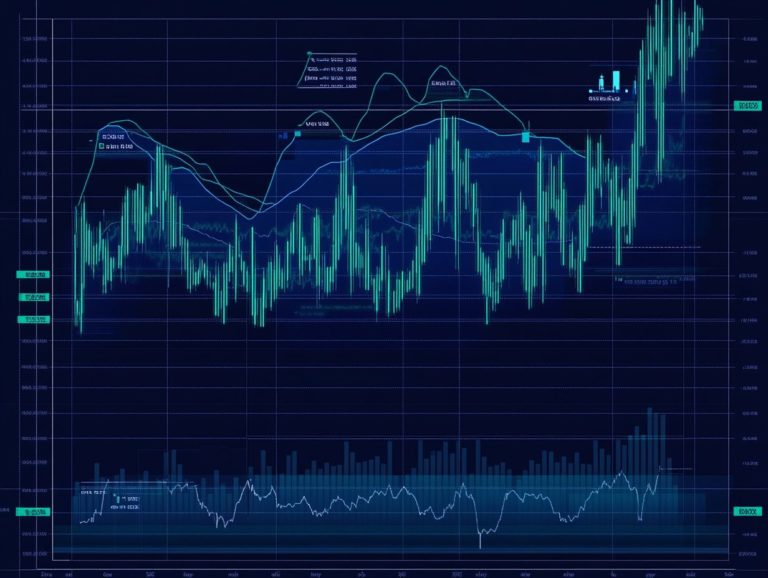Understanding the Impact of Liquidity in Trading
Liquidity is essential in trading, determining how easily you can buy or sell assets without impacting their price.
This article delves into the various types of liquidity market (the ease of trading securities) and asset (how quickly an asset can be converted to cash) emphasizing how factors such as supply and demand, along with market volatility, influence liquidity levels.
You ll discover different liquidity measurement tools, weigh the pros and cons of trading under varying liquidity conditions, and explore effective strategies for maneuvering through illiquid markets.
Dive in with us as we explore why liquidity matters in trading!
Contents
Key Takeaways:

- Liquidity means how easily you can buy and sell assets on the market, and it is crucial for traders to understand its impact on their trades.
- Supply and demand and market volatility are key factors that affect liquidity, and traders should be aware of these when making trading decisions.
- Low liquidity can have both advantages and disadvantages, and traders should have strategies in place to deal with it effectively. Best practices for trading in illiquid markets include diversification and thorough risk management.
Defining Liquidity and its Importance
Liquidity is a crucial concept in financial markets, representing how easily you can buy or sell assets without significantly impacting their market price.
It spans various dimensions, including market liquidity and asset liquidity, both of which are important for your investment choices and managing risk.
Understanding liquidity is essential for all market participants, as it directly affects trade execution, funding liquidity, and the overall stability of financial systems.
During liquidity crises, the consequences can be far-reaching, influencing everything from high-volume trades in large-cap stocks to the performance of small-cap stocks and exotic currency pairs.
Market liquidity is all about your ability to swiftly buy or sell assets in the marketplace. In contrast, asset liquidity focuses on how easily you can convert specific assets into cash.
For example, cash and government bonds are considered highly liquid, while real estate and collectibles may require more time and effort to sell.
Understanding this distinction is vital; liquidity risk can lead to unfavorable pricing when market conditions are tumultuous.
To navigate this landscape effectively, employing robust liquidity management strategies such as holding a diversified portfolio of liquid assets or maintaining liquidity reserves can help you mitigate potential risks.
Staying vigilant about your liquidity positions allows you to respond swiftly to market shifts and safeguard against losses.
Types of Liquidity
Grasping the various types of liquidity is crucial for you as an investor or market participant, as it can profoundly influence your investment choices and risk management strategies.
Two primary forms to consider are market liquidity, which pertains to how effortlessly securities can be traded, and asset liquidity, which outlines how swiftly and efficiently an asset can be transformed into cash.
Understanding the difference between liquid markets and illiquid assets becomes particularly vital during times of market volatility, impacting everything from trade volume to bid-ask spreads.
Market Liquidity vs. Asset Liquidity
Market liquidity refers to your market’s ability to buy and sell assets easily. In contrast, asset liquidity focuses on the individual characteristics of assets that affect how quickly they can be converted to cash.
You can measure market liquidity through factors like trade execution speed, bid-ask spreads, and market depth. Asset liquidity depends on the demand and supply dynamics of a specific asset.
Understanding the difference between market and asset liquidity is crucial for traders. This knowledge is especially important during high-volume trades or in times when it’s tough to buy or sell assets.
For example, securities on major exchanges, like blue-chip stocks, usually have high market liquidity. This allows for large trades without affecting prices too much.
In contrast, niche assets, such as collectibles or certain bonds, might have low asset liquidity. This can make it hard to quickly convert them into cash without losing money.
During periods of market volatility, the gap between market and asset liquidity becomes clear. You may struggle to execute trades in less liquid markets, which can increase financial risk.
Recognizing how liquidity variations impact your trading strategies and investment decisions is essential. This understanding helps you navigate the complexities of financial markets effectively.
Factors Affecting Liquidity
Several factors can influence liquidity in financial markets. The dynamics of supply and demand are key players in this arena.
Market volatility, often triggered by economic events or shifts in investor sentiment, significantly shapes liquidity risk. It affects how easily assets can be traded at market prices.
The importance of liquidity changes across different asset classes, from cash equivalents and liquid securities to more complex derivatives and illiquid assets. This variation impacts how financial obligations are managed in the market.
Supply and Demand

The relationship between supply and demand is essential for understanding liquidity levels in financial markets. When demand for an asset exceeds its supply, you ll see an increase in market liquidity, enabling smoother trade execution and better prices.
Conversely, if there s too much supply and demand falls, you may notice a widening bid-ask spread and decreased trade volume, indicating lower liquidity.
This relationship is crucial for traders and investors. It allows you to navigate market conditions more effectively.
Take a booming real estate market, for instance. When demand for homes rises, it often leads to multiple offers, resulting in faster sales and higher prices.
However, if a surplus of homes floods the market while demand stays the same, sellers may need to lower their prices. This scenario can reduce overall trade volume.
In the stock market, good news about a company s promising earnings can ignite demand, enhancing liquidity as more investors rush to buy shares. On the other hand, if bad news leads to a sell-off, the resulting imbalance can hinder liquidity, making it harder to sell without impacting prices.
Market Volatility
Market volatility can profoundly impact your liquidity risk the risk of being unable to buy or sell assets without causing a significant change in their price. Sudden price fluctuations often lead to diminished liquidity in market systems. When volatility spikes, you may hesitate to engage in trades, worried that rapid price changes could result in financial losses.
This hesitation can make liquidity issues worse, making effective liquidity management crucial for you as an investor aiming to uphold your positions in these fluctuating markets. This makes liquidity even more important during high-volatility periods, as it directly influences your investment strategies and overall financial health.
Understanding this relationship is vital for your success as a market participant, enabling you to navigate the complexities of unpredictable environments. During volatile times, the spread between buying and selling prices can widen significantly, complicating the trading landscape further.
If you overlook these dynamics, you may struggle to exit positions or face unexpected transaction costs.
Implementing robust liquidity management practices is not merely a tactical consideration; it is a strategic necessity for you, ensuring that your investments remain safeguarded amid ever-changing conditions.
Measuring Liquidity
Measuring liquidity is crucial for grasping the dynamics of financial markets and the ease with which you can trade various assets. You ll find several liquidity measures at your disposal, such as liquidity ratios like the quick ratio and current ratio. These help you assess an asset’s liquidity in relation to its financial obligations.
Furthermore, indicators like the bid-ask spread (the difference between the buying and selling price of an asset) and market depth (the market’s ability to sustain relatively large market orders without impacting the price significantly) provide valuable insights into how easily an asset can be traded at current market prices. These indicators serve as essential liquidity examples, illustrating the effectiveness of various trading strategies.
Liquidity Ratios and Indicators
Liquidity ratios are critical financial metrics that help you assess an entity’s ability to meet its short-term obligations. Among the most widely used are the current ratio and quick ratio, both of which shed light on a company’s short-term liquidity position. The acid-test ratio takes it a step further, providing a stringent measure of liquidity that allows you to evaluate the immediate financial situation. Grasping these liquidity metrics is essential for investors, creditors, and financial analysts alike.
Each of these ratios offers a distinct viewpoint on a company s financial health. The current ratio, which you calculate by dividing current assets by current liabilities, reveals how easily a firm can cover its short-term debts with its assets. If the ratio is above one, you can breathe a sigh of relief; it indicates adequate liquidity. Conversely, a lower figure might raise some eyebrows and warrant further investigation.
The quick ratio takes a more conservative approach by excluding inventory from current assets, which is particularly useful in industries where inventory turnover is sluggish. Meanwhile, the acid-test ratio is the strictest of the bunch, focusing solely on cash and near-cash assets to emphasize immediate liquidity.
In times of economic uncertainty or when considering potential investment opportunities, you ll often find investors and analysts relying on these ratios to gauge financial stability. Understanding and applying these metrics can greatly enhance your decision-making process.
The Impact of Liquidity on Trading
Liquidity is fundamental in trading, influencing everything from how trades are executed to the pricing of assets. For you as an investor or trader, it s a key factor to consider.
When liquidity is high, you typically enjoy lower transaction costs and tighter bid-ask spreads, which can significantly enhance your trading experience. On the other hand, low liquidity can lead to greater market volatility and wider bid-ask spreads, presenting a unique set of challenges and opportunities.
Understanding liquidity isn’t just good practice it’s crucial for seizing opportunities in a fast-paced market! Grasping the importance of liquidity is essential for crafting effective trading strategies that are in tune with prevailing market conditions.
Advantages and Disadvantages

The advantages and disadvantages of liquidity are vital for understanding trading dynamics in financial markets.
High liquidity promotes efficient trade execution, leading to accurate market pricing and lower transaction costs. Low liquidity can impede trade execution and invite price manipulation, creating dilemmas for traders and investors. Grasping the significance of liquidity is essential for navigating complexities in both liquid and illiquid markets.
In a highly liquid market, you can buy or sell substantial volumes of assets without drastically affecting the price. This is particularly crucial during sudden market movements.
On the flip side, in a low liquidity scenario, executing large trades might lead to significant price shifts. This can make you susceptible to slippage which means the difference between expected and actual prices or unfavorable fills, where trades are executed at poorer prices than intended. Such inconsistencies can distort your perception of investment value and pose risks when trying to enter or exit positions quickly.
Ultimately, understanding these dynamics can transform your trading strategies, risk management, and overall behavior in the market.
Strategies for Dealing with Low Liquidity
Navigating low liquidity in financial markets requires a refined approach to managing how easily you can buy or sell. This helps mitigate risks while optimizing trade execution.
As an investor or trader, adapting your strategies is essential to effectively maneuver through challenges posed by illiquid markets. Techniques such as employing limit orders, diversifying your portfolio, and timing your trades can significantly enhance your chances of success.
Understanding the intricacies of low liquidity is vital for anyone aiming to maintain profitability and minimize losses in unpredictable conditions.
Best Practices for Trading in Illiquid Markets
Trading in illiquid markets poses distinct challenges. To manage liquidity effectively, consider utilizing limit orders to avoid unfavorable trade executions that can derail your strategy.
Diversifying your portfolio is also essential; this helps spread risk and creates a safety net for your investments.
By carefully timing your trades and analyzing market conditions, you can significantly improve trade execution and profitability in these tricky environments.
Act now to navigate these challenging waters effectively! Explore staggered order placements to mitigate the impact of large trades on market prices, leading to more favorable entry points and minimizing slippage.
Employing advanced analytical tools to monitor real-time market trends is invaluable for identifying optimal trading windows. Successful traders often utilize historical data to uncover patterns that inform their strategies.
By combining a disciplined approach with these strategies, you can not only survive but thrive in illiquid markets. Start applying these strategies today to enhance your trading success!
Frequently Asked Questions
What is liquidity in trading and why is it important?
Liquidity refers to how easily an asset can be bought or sold in the market. In trading, it is crucial because it allows for fast and efficient execution of trades, reduces the risk of price fluctuations, and provides opportunities for buying and selling at fair prices.
How does liquidity impact the overall market?

Liquidity directly impacts the overall market by affecting the supply and demand of assets. High liquidity often leads to more stable prices and increased trading activity, while low liquidity can result in volatile market conditions.
What are the different types of liquidity in trading?
The two main types of liquidity in trading are market liquidity and funding liquidity. Market liquidity refers to the ease of buying and selling an asset, while funding liquidity is the availability of cash or credit to finance trades and investments.
How can a lack of liquidity affect traders?
A lack of liquidity significantly impacts traders. It makes entering or exiting positions at desired prices difficult.
This situation increases transaction costs and may lead to price manipulation. Ultimately, it can limit trading opportunities and affect profitability.
What factors can impact trading liquidity?
Several factors influence liquidity, including economic conditions and market volatility. Regulatory changes and news events also play a crucial role.
The size and depth of the market, along with trading volume and the order book, further determine liquidity.
How can traders manage liquidity risk?
Traders can manage liquidity risk by diversifying their portfolios. Conducting thorough research before making trades is essential.
Keeping a close eye on market conditions is vital. They should also use risk management strategies, like stop-loss orders, to limit potential losses during unexpected liquidity changes.






